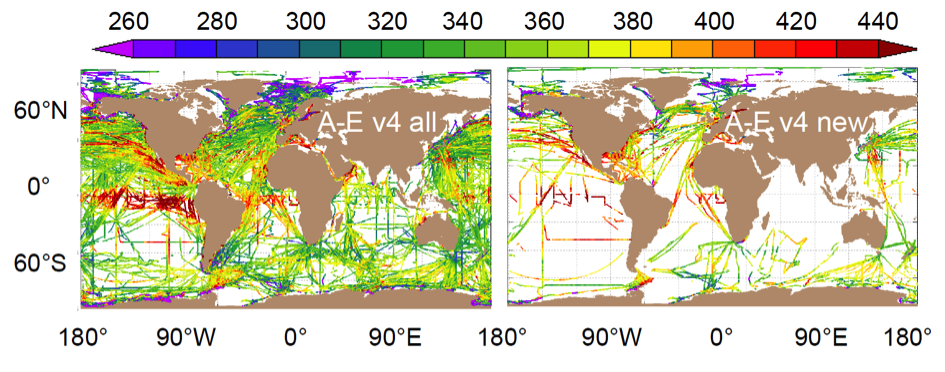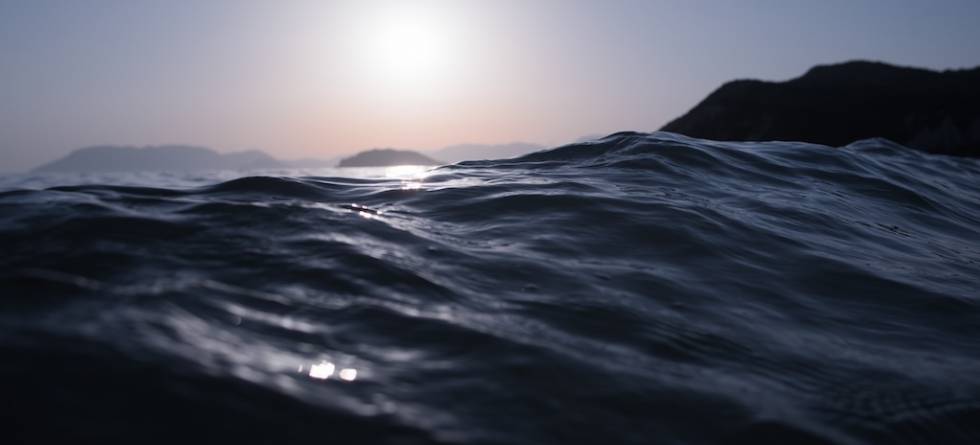Once again SOCAT has released a new version of quality controlled fCO2 (fugacity of CO2) observations. The new release contains 18.5 million observations for the global oceans and coastal seas from 1957 to 2015 (see Fig. 1) – this is 4 million more observations than version 3. Version 4 represents a long term accomplishment for the SOCAT contributors by being the first release based on automated data ingestion. Many PIs used the new automated data ingestion system, uploaded data themselves and performed initial quality checks before they submitted the data to further quality control. This automation system speeded up the data submission and quality control procedures and will in the future allow annual releases of SOCAT, starting from version 4.
To understand the significance of the SOCAT effort we have to go back to the early 2000s – a time when surface ocean CO2 data was spread around at different institutes around the world, often hidden away on personal computers. This situation made it very time consuming and close to impossible to get an overview of the global ocean carbon distribution and its fluctuations. The international marine carbon research community knew that something needed to change if their research was to make further progression. In 2007 the community, supported by UNESCO/SCOR’s International Ocean Carbon Coordination Project (IOCCP), agreed to take on the huge task of establishing a global surface CO2 data set that would bring together a standardized and quality controlled fCO2 synthesis product. Despite the lack of funding, the first version of the synthesis product was released in 2011. The first version was later on succeeded by new releases with new and updated datasets and the data stream handling and quality control procedures were improved between each release.

SOCAT has been a success ever since the release of the first version and everyone who contributes becomes a co-author on the publication describing SOCAT (Pfeil et al., 2013; Bakker et al., 2014, 2016). This synthesis activity would simply not exist without the long-term voluntary community effort and commitment from the international marine carbon research community. Before the 4th release, SOCAT was cited or named in more than 160 peer-reviewed scientific publications and 15 high-impact reports, and have been a key element in the annual Global Carbon Budgets. SOCAT has enabled quantification of the ocean carbon sink and ocean acidification, and evaluation of ocean biogeochemical models. No one could from the start have anticipated the scientific impact or the long continuation of SOCAT, especially considering the lack of funding for the many people involved.
The more than 100 contributors to SOCAT consists of passionate data providers, quality controllers and data managers who believe that data synthesis, which are easily discoverable, accessible and citable, is the way forward. The SOCAT effort represents a milestone in research coordination, data access, biogeochemical and climate research and in informing policy. Researches and data managers from BCCR and the Bjerknes Climate Data Centre (BCDC), employed at the University of Bergen and Uni Research, have been involved in every step since the beginning in 2007, and up to the release of version 4. These people are Abdirahman Omar, Are Olsen, Benjamin Pfeil, Camilla S. Landa, Ingunn Skjelvan, Siv Lauvset, Steve Jones and Truls Johannessen.
There are still unanswered questions within ocean carbon research, but version 4 of SOCAT may bring us a step closer to unraveling their answer. If you wish to contribute on this quest you can get access to the version 4 data here.

